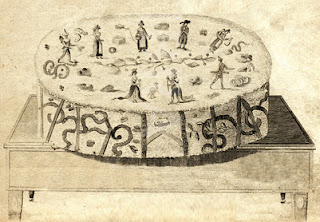*PLEASE NOTE EDIT: the next event is planned to take place on 20 Dec. 2017, 7 - 8.30 pm, at Mrs. Leach's establishment in Derby.
I hope that this seasonal offering will become an annual tradition in itself; this year's December talk - which forms part of the series of events that I intend to hold until summer 2018, concentrating on the time in which Britain's favourite female author lived and died, as part of the Bicentenary commemorations - will focus on the 'Age of Austen'
Centring on the 1770s - 1810s, the Christmastide talk considers celebrations before those of the Victorian period, with which many today are more familiar. In order to explore continuities (some of which have evolved into modern-day practices) and change (resulting in the loss of once popular customs), I will also include information about the two decade's between Jane Austen's death, and the start of Queen Victoria's reign, thus examining the late Georgian & Regency eras more fully, and including an array of attractive and intriguing material.
I shall approach the topic through a number of themes to over-view attitudes, beliefs, and customs of the time surrounding Christmas past and present, using Jane Austen's work, and early biographies; a range of written and audio sources and images, including diaries and letters, newspapers & magazines, literature, poetry, and music; prints & art; and - of course, from an archaeological perspective - various aspects of material culture. This array of sources will pay particular attention to Derby, Derbyshire, and the East Midlands.
The themes begin with 'Ancient Origins & Antiquarian 'Inventions'. This will touch upon pre-Roman, Classical, Medieval and Early Modern traditions, by considering Antiquarian interest in and '(re-)envisioning' of Christmas customs in the late 18th and early 19th centuries. It will explore concerns of the 'Austen Age' that Christmas and other ancient English customs were under threat, considering how this related to war, urbanisation, and industrialisation, and measures taken to preserve 'olde' ways. (This will integrate my own ongoing research into the effects of Antiquarianism upon ritual and belief in the past).
The second theme, 'Festive Families and Community Care', will explore Christmas trade and travel, briefly considering commerce, holidays, and transportation - notably that popular seasonal motif: coach travel; and the most significant factor of the Victorian (and subsequent) Christmas: the family. It will also touch upon faith and belief; and explore charity and gift-giving at Christmas time.
The final theme - '
Festive Food, Fun, and Games' - will look at seasonal amusements & pastimes, including the theatre, community entertainments, and domestic traditions, such as card-playing and party games. No exploration of Christmas would be complete without a foray into food and drink, which will conclude the talk, considering recipes of the day, and how food and drink was integrated with the Christmas calendar, and customs.
The event will be held in the 'common parlour' of the 'Academy', which (though limiting the number of available places)[1] enables the creation of a cosy 'atmosphere', through colour and candlelight, fabrics and furniture (& possibly firelight!),[2] and material culture and costume. I will as usual (in the guise of Mrs. Leach) be clothed in period dress - and 'Academy pupils' garbed in their own Regency- and late Georgian-style attire will be welcome!
Tickets cost £3.50 pp (purchases online accruing an additional
Eventbrite fees of 87p), and may be obtained online by clicking
this link; the 'Buy Tickets' button bellow; the 'Register' buttons at the top right of the webpage, or by using the form at the end of this post.
Update: Early Bird offer has now expired, but there's a discount of £1 for those who attend in Regency costume! Enter the promo code Costume_Concession
Tickets may also be obtained on request by email: antiquarianacademy@gmail.com, or text: 07903 237953 (Paypal); or by post: Lymehurst, 1 West Park Rd., Derby, DE22 1GG (cheque & SAE).
It would be great to know if readers are interested in this event - even if unable to attend (so that I might better plan this and future events), using website comments,
Twitter,
Facebook; or email.
I hope to see some readers at the event!
Notes
[1] A minimum number of places need to be filled for the event to proceed.
[2] Should conditions be suitable.

























